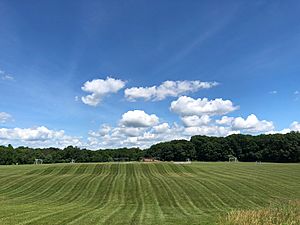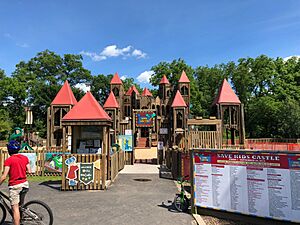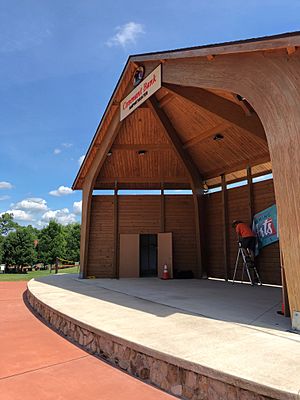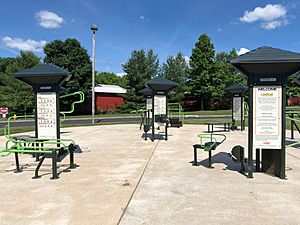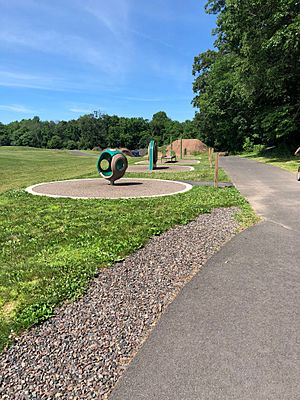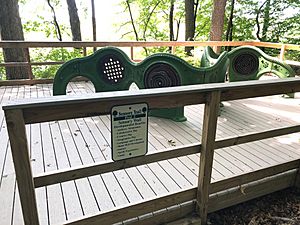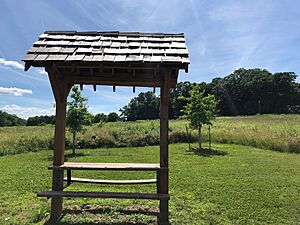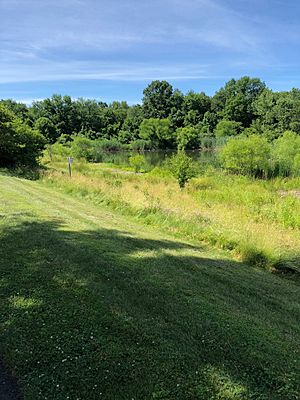Doylestown Central Park facts for kids
Quick facts for kids Doylestown Central Park |
|
|---|---|
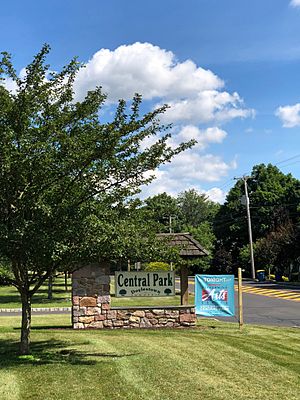
Main entrance to Doylestown Central Park, located on Wells Rd.
|
|
| Lua error in Module:Location_map at line 420: attempt to index field 'wikibase' (a nil value). | |
| Type | Municipal park |
| Location | Doylestown Township, Pennsylvania |
| Area | 125.5 acres (50.8 hectares) |
| Created | 1995 |
Doylestown Central Park is a huge park in Doylestown Township, Pennsylvania. It covers about 125.5 acres, which is like 95 football fields! It's the biggest park in Doylestown Township.
A small part of the park, about 30 acres, is rented out to Delaware Valley University. They use this land for farming.
The park helps people stay healthy and active. It also protects nature and helps the local economy. These goals fit with plans for parks all over Pennsylvania. Central Park has lots of fun things to do. You can find basketball courts, tennis courts, and soccer fields. There are also many walking trails. The park also has special spots like Kid's Castle and a sensory trail.
Contents
What Can You Do at the Park?
Doylestown Central Park is open every day from morning until evening. It has both green spaces and areas for sports and fun.
Here are some things you can do there:
- 5 tennis courts
- 2 basketball courts
- 3 soccer fields
- A bocce court
- A golf link
- An amphitheater for shows
- A play area for toddlers
- Kid's Castle
- Trails for hiking, walking, or biking
The tennis and basketball courts have special lights. You can turn them on with coins to play after dark!
How Did Central Park Start?
Central Park officially opened to the public on June 10, 1995. The land was bought in 1991 for $3.7 million. It was purchased from a company that wanted to build houses.
Before that, the land belonged to Delaware Valley University. Planners thought it was a great spot for a park. It was right next to a township building. This meant it was easy to connect to water, sewer, and electricity lines. This saved time and money when building the park.
From the start, planners wanted the park to have quiet areas and active areas. They also wanted to change the natural landscape as little as possible. In 1994, the township received a grant of $100,000 to help build the park. By that year, the parking lots, tennis courts, basketball courts, and walking trail were all finished.
Fun Stuff to Explore!
Explore Kid's Castle!
Kid's Castle is a super cool playground. It was inspired by the unique castles built by Henry Chapman Mercer in the area. It opened on June 22, 1997.
Local architects and students from the Central Bucks School District helped design it. A special architect named Bob Leathers helped make the final design. In 2012, a group called "Friends of Kid's Castle" formed. Their goal is to protect this amazing playground.
The original castle was made of wood. After lots of use and weather, it needed repairs. In March 2013, Kid's Castle had a big renovation. It cost $150,000 and took almost 7 months to finish. The main castle is open now. Some older playground equipment was removed during the renovation. The next steps include adding new equipment. They also plan to make the ground surfaces better for kids of all abilities. This next part of the renovation will cost $600,000.
Catch a Show at the Amphitheater!
In 2007, people in Doylestown said they really wanted an amphitheater in Central Park. About 66% of residents thought it was important! So, building one became a top goal for the park.
Planners wanted the amphitheater to be a central spot in the park. It wasn't just another building. It cost $136,000 to build. This money came from 20 years of fundraising efforts!
The amphitheater has a stage, a storage area, a changing room, and a bathroom. It hosts music concerts and free movies during the summer. Even before the building was there, the hillside was used for concerts. The first concert series happened there in the summer of 1995.
Hit the Trails: Walk, Run, or Bike!
Doylestown Central Park is the end point of the 8.5-mile long US 202 Parkway Trail. This paved trail runs next to U.S. Route 202. It goes all the way to Pennsylvania Route 63 in Montgomeryville. There are plans to make the trail even longer, extending it into Norristown.
You can easily get to the trail from a parking lot on New Britain Road.
The park also connects to the Doylestown Hike and Bike System. One connection is between the park and the nearby Klutz Elementary School. This system started planning in 1992 and is still growing. Its goal is to connect schools, parks, and other places around the township.
Get Fit on the Fitness Trails!
Central Park has several fitness stations along its walking trails. These stations help you get a good workout outdoors. When the weather is nice, you can even join outdoor boot camp classes. They happen on Monday and Wednesday evenings from 6:00-7:00 pm.
There's also a special "LifeTrail" area for adults aged 50 and older. Each station has clear pictures showing how to use the equipment. It also shows different levels of difficulty. You can even watch a video online to learn how to use the equipment!
Explore the Sensory Trail!
The Sensory Trail opened in October 2016. The easiest way to get there is from the New Britain Road entrance. This trail has 9 different sections, called "pods." Some pods are along the walking path. Others are in Hart's Woods, along a boardwalk. Five of the pods are easy to use for people in wheelchairs.
Each pod helps you use your senses in new ways. It's designed to help children with different needs, especially those on the autism spectrum, connect with nature. This sensory trail is believed to be one-of-a-kind in Pennsylvania!
The park wanted to make Central Park welcoming for everyone. That's why they created the sensory trail. It cost $442,000 to build. Many groups and grants helped pay for it. The Doylestown Township, Foundations Community Partnership, Doylestown Lions Club, and others contributed. More donations could help expand the trail even further.
Park Wildlife
The Meadow
The meadow is a quiet, natural part of the park. This area is not mowed. It provides a valuable home for many different animals and plants. This includes the native Bluebird.
The Bucks County Audubon Society and local community members wanted to help bluebirds. They built and placed nesting boxes in the park and nearby areas. This effort has been very successful! In 1992, only 2 bluebirds were seen. By 2015, 100 or more bluebird chicks were hatching each year! Park staff do some work to keep shrubs and trees from growing too much in the meadow.
Here are some species you might find in the meadow:
- Eastern tiger swallowtail, Papilio glaucus (a type of butterfly)
- American grasshopper
- Red-winged blackbird
- Milkweed (a plant)
- New York ironweed (a plant)
- Goldenrod (a plant)
Storm Water Pond
Near Kid's Castle, across a bridge, you'll find a storm water pond. This pond collects extra rainwater runoff. There's a sign next to the walkway. It explains why it's important to keep our waterways clean. This pond is a peaceful part of the park. It's a home for wildlife, and visitors can enjoy seeing nature there.
Hart's Woods
A part of an old forest called Hart's Woods is still in Doylestown Central Park. This forest used to be much larger. The soil here is very fertile clay. It helps big Oak and Beech trees grow.
Hart's Woods is home to many different species, including:
- American beech, Fagus grandifolia (a tree)
- Red Oak, Quercus rubra (a tree)
- Spicebush, Lindera benzoin (a shrub)
- False Solomon's Seal, Maianthemum racemosum (a plant)
- Wood thrush (a bird)
- American woodcock (a bird)
- Ovenbird (a bird)
To protect these animals and plants, Hart's Woods is a special wildlife area. Dogs are not allowed in this part of the park.
Environmental Education Area
In 2004, Doylestown planned to add 23 more acres to the park. This new area became the Environmental Education Area. Just like the rest of the park, the goal was to change the natural land as little as possible.
A walking trail in this area connects to Kid's Castle. It also connects to a nearby neighborhood and Kutz Elementary School. With funding from different groups, the Environmental Education Area officially opened in 2006. A wetland education trail was finished in 2011. The Edgar N. Putman Environmental Education Center opened on May 13, 2011. An invasive species trail was completed in January 2012.
Besides regular visitors, the Environmental Education Area is used for many programs. These include "No Child Left Inside" and park recreation programs. The outdoor classroom is a central spot for these activities.
Invasive Species
Doylestown Central Park wants to teach visitors about invasive species. These are plants or animals that are not native to an area. They can harm the existing habitats. Signs in the park explain how to manage them. This includes finding them early, removing them by hand, or using chemicals.
The signs also give tips for visitors to help. These tips include learning about invasive species. They also suggest not planting them in gardens. You can also remove them, disturb the landscape as little as possible, and limit fertilizer use.
Here are some plants known to be invasive in Pennsylvania:
- Canada Thistle
- Multiflora Rose
- Johnson Grass
- Kudzu
- Purple Loofestrife
- Common Reed Grass
You can find a longer list of invasive species on the Pennsylvania Department of Conservation and Natural Resources website.


